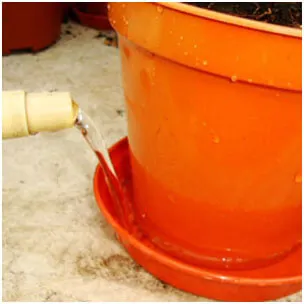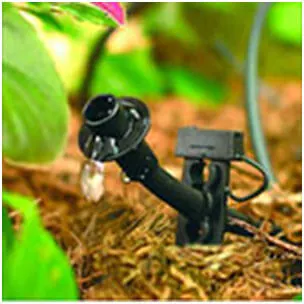 While plant drip trays are often seen as a practical solution for preventing water damage and maintaining a tidy indoor gardening environment, they can introduce a host of problems that make more mess than they keep clean and ultimately harm your plants. In this article, we’ll delve into the drawbacks of drip trays and explore more effective alternatives, such as drip irrigation and sealing planters and keeping plants in their original plastic pots.
While plant drip trays are often seen as a practical solution for preventing water damage and maintaining a tidy indoor gardening environment, they can introduce a host of problems that make more mess than they keep clean and ultimately harm your plants. In this article, we’ll delve into the drawbacks of drip trays and explore more effective alternatives, such as drip irrigation and sealing planters and keeping plants in their original plastic pots.
The Downsides of Drip Trays
- Making More Mess than they solve: One of the most frustrating aspects of using plant drip trays is their tendency to overflow, often creating more mess than they solve. When drip trays become full, excess water can spill over the edges, soaking the surrounding area and potentially damaging floors, furniture, or other valuable items. This can be particularly problematic in homes with hardwood floors or carpets, which can be stained or damaged by water.
- Root Rot and Fungal Diseases: One of the most significant issues with drip trays is their potential to contribute to root rot and fungal diseases. When excess water accumulates in the tray, it can create a stagnant environment that is ideal for the growth of harmful pathogens. These pathogens can infect the roots, leading to root rot, which can quickly kill a plant.
- Attracting Pests: Standing water in drip trays can also attract pests, such as mosquitoes and gnats. These insects can lay eggs in the water, leading to infestations that can be difficult to control. Additionally, pests can transmit diseases to your plants, further compromising their health.
- Aesthetics and Maintenance: While drip trays can help to protect floors and furniture from water damage, they can also be unsightly and require regular maintenance. They can collect dirt, debris, and algae, making them difficult to clean. Additionally, large drip trays can be cumbersome to move, especially when filled with water.
- The High Cost of Drip Trays for Large Planters
One of the often-overlooked drawbacks of using drip trays for large planters is the significant cost involved. The material required to construct a drip tray for a large planter is often equivalent to the material needed to make a planter of similar size. This means that investing in a drip tray can be a costly endeavour, especially for those with multiple large planters.
Effective Alternatives to Drip Trays
 Drip Irrigation: Drip irrigation is a highly efficient watering method that delivers water directly to the roots of your plants. This helps to prevent overwatering and reduces the risk of root rot and fungal diseases. Drip irrigation systems are typically less expensive than drip trays and require minimal maintenance.
Drip Irrigation: Drip irrigation is a highly efficient watering method that delivers water directly to the roots of your plants. This helps to prevent overwatering and reduces the risk of root rot and fungal diseases. Drip irrigation systems are typically less expensive than drip trays and require minimal maintenance.- Sealing Planters and Keeping Plants in Original Pots: First seal the drainage holes by applying silicone caulk, epoxy resin, or even a layer of concrete to the bottom of your planter to create a waterproof barrier. Then use the original plastic pots, which have built-in drainage holes. This allows excess water to drain freely, reducing the risk of root rot. You can then place the plastic pots in the larger decorative containers for a more aesthetically pleasing appearance.
Updated Content: Here are some other options for watering your indoor plants without using drip trays:
- Self-Watering Planters:
- How it works: These planters have a reservoir at the bottom that is connected to the soil through wicking material. As the soil dries out, moisture is drawn up from the reservoir.
- Benefits: Reduces the need for frequent watering and helps to maintain consistent soil moisture levels.
- Watering Spikes:
- How it works: These spikes are inserted into the soil and filled with water. The water is slowly released into the soil, providing a steady supply of moisture.
- Benefits: Easy to use and can be used for a variety of plant sizes.
- Bottom Watering:
- How it works: The plant pot is placed in a tray filled with water. The water is absorbed through the drainage holes in the bottom of the pot.
- Benefits: Helps to prevent overwatering and can be effective for plants that prefer moist soil.
- Wick Watering:
- How it works: A wick is placed in a container of water and then inserted into the soil. The water is drawn up through the wick and into the soil.
- Benefits: A simple and effective method for watering small plants.
- Humidity Trays:
- How it works: A tray filled with pebbles is placed under the plant pot. The pebbles are then covered with water. As the water evaporates, it increases the humidity around the plant.
- Benefits: Helps to create a more humid environment, which is beneficial for some plants.
By carefully considering the drawbacks of drip trays and exploring these alternative options, you can choose the best approach to watering your plants and maintaining a healthy indoor gardening environment. Remember, the key to success is to avoid overwatering and to provide your plants with the right amount of moisture to support their growth and development.



0 Comments